New Micron Mobile 32GB 3D NAND memory technology delivers better quality, performance and reliability for next-generation mobile multimedia and streaming experiences
SANTA CLARA, Calif., Aug. 09, 2016 (GLOBE NEWSWIRE) — Micron Technology, Inc., (Nasdaq:MU) today introduced the company’s first 3D NAND memory technology optimized for mobile devices and its first products based on the Universal Flash Storage (UFS) 2.1 standard. Micron’s initial mobile 3D NAND-based 32GB solution is targeted specifically for the high and mid-end smartphone segments which make up approximately 50 percent of worldwide smartphone volume[1]. As mobile devices bypass personal computers as consumers’ primary computing device, user behaviors heavily impact the device’s mobile memory and storage requirements. Micron’s mobile 3D NAND addresses these concerns, enabling an unparalleled user experience that includes seamless high definition video streaming, higher bandwidth gameplay, faster boot up times, camera performance and file loading.
“Micron continues to advance NAND technology with our introduction of 3D NAND and UFS products for the mobile segment,” said Mike Rayfield, vice president of Micron’s mobile business unit. “The improved performance, higher capacity and enhanced reliability of 3D NAND will help our customers meet the ever-growing demand for mobile storage and will enable much more exciting end user experiences.”
To meet the elevated hardware demands stemming from increased mobile video and multimedia consumption, as well as the anticipated increased storage demands that will result from the introduction of 5G wireless networks, Micron 3D NAND technology stacks layers of data storage cells vertically with extraordinary precision to create storage solutions with three times more capacity than previous generation planar NAND technologies. Because capacity is achieved by stacking cells vertically, Micron is able to pack more storage cells into a much smaller die area, resulting in the delivery of the industry’s smallest 3D NAND memory die measuring only 60.217mm2. A smaller die enables a tiny memory packaging footprint which can free up space for additional mobile battery size or enable smaller form factor devices.
“3D NAND technology will be vital to the continued development of smartphones and other mobile devices,” said Greg Wong, founder and principal analyst at Forward Insights. “With the advent of 5G and mobile’s increasing influence in our digital lives, smartphone makers are in need of the most advanced technology to store and manage the ever-increasing volume of data. Micron’s 3D NAND for mobile is well suited to address the market’s evolving data storage needs by enabling a more seamless user experience for high resolution video, gaming, and photography.”
3D NAND: Powering the Changing Mobile Landscape
Micron’s first 3D NAND for mobile offers several competitive technical advantages. New features include:
- Industry’s first mobile product built on floating gate technology, a universally utilized design refined through years of high-volume planar flash manufacturing
- Micron’s first memory devices with UFS 2.1 standard, which enable best-in class Sequential Read Performance for the mobile market
- 3D NAND-based multichip packages (MCPs) also include low power LPDDR4X, providing up to 20 percent more energy efficiency than standard LPDDR4 memory
- Industry’s smallest 3D NAND memory die, measuring only 60.217mm2, allows tiny memory packaging ideal for ultra-small form factor devices; Micron’s 3D NAND die is up to 30% smaller than planar NAND die of the same capacity.
Micron’s 3D NAND solutions for mobile are now sampling with mobile customers and partners and will be widely available by the end of 2016.
[1] Source: Micron internal forecast



















